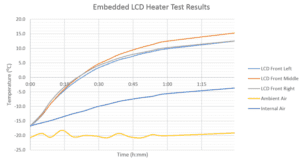LCD SIGN OPERAITO IN SUB-ZERO TEMPERATURES: THE PROBLEM
As the name suggests, the liquid crystal between two polarising filters fills a Liquid-crystal display unit (LCD Sign). In low-temperature environments, this liquid crystal suffers from a loss of brightness and slower response times. In sub-zero environments without supplemental heating, the liquid-crystal can freeze and cause the screen to stop functioning.
Traditional methods of warming LCD displays in sub-zero environments have three main drawbacks:
- They are inefficient and increase the cost of ownership.
- They create hot spots in the LCD matrix which can damage the display. This is due to heat not travelling well laterally or vertically across the panel.
- There is a high risk of condensation forming on the LCD. Condensation can consequently shorten the life of electronics and accelerate corrosion.
THE SOLUTION
As a result of the 3 drawbacks listed above, We developed a series of rugged high bright LCD signs. These displays are capable of operating between -40 to +50 degrees Celsius.
-
EFFICIENCY AND COST OF OWNERSHIP
Air is a fantastic insulator. In fact, when you put on a coat in winter, it’s not the wool or synthetic fibres that keep you warm. Rather, it’s the tiny pockets of air the coat traps around your body that helps insulate you from the cold. By using this principle we have created a pocket of still air around the screen. As a result, this air pocket enables to reduce thermal loss and keep heat where it needs to be, inside the panel.
-
LCD SIGN HOT SPOTS
Our embedded heating solution distributes heat evenly across the entire pane, therefore reducing the risk of hot spots.
-
LCD SIGN AND CONDENSATION
Our embedded heater raises the temperature of the display quicker than the temperature of the surrounding insulating air. As a result, the risk of condensation is reduced.
HOW WE TESTED OUR LCD SIGN FOR SUB-ZERO TEMPERATURES
To verify the design, we hired an industrial freezer and tested an LCD sign for months on end. We cycled the temperature to test different heating configurations and evaluate reliability.
The following graph displays the results.

The key points to take away from the graph are:
- The LCD sign warmed to above 0oC in under 18 minutes in a -20 oC ambient environment.
- The LCD sign heated evenly across the whole surface (left, middle and right).
- The internal insulating air pocket temperature remained below the LCD sign temperature and reduced the risk of condensation forming.
IMMEDIATE OPERATION OF YOUR LCD SIGN
If 18 minutes is too long to wait for the display to reach the optimum operating temperature, our ruggedized displays do support immediate operation in sub-zero environments. The tradeoff is a reduced response time for each pixel until the screen warms to above 0oC. Yet, for largely static images like those used on passenger information displays (PID’s) this is not an issue. As seen in the videos below, there is motion blur for fast movements, whereas slow movements or transitions were still highly legible.
REMOTE MANAGEMENT OF OUR LCD SIGN
You can remotely manage screen heating to optimise power consumption and monitor temperatures. This is done through our networked monitoring and control solution (the MPMS).
The Metromatics PID Monitoring System (MPMS) was designed in Australia. The MPMS provides remote monitoring and control of Passenger Information Displays (PID) and digital signage. Its compatibility with SNMP allows ease of interface with existing IT infrastructure and management tools. The integrated Ethernet switch forwards network traffic to other devices without additional hardware and creates a simple cost-effective design.
The configurable inputs and outputs mean the MPMS can interface with 3rd party hardware. Third-party hardwares include temperature, power, door, shock sensors, fans, modems, video cards, heating pads, humidity controllers and power relays. As a result, this combination makes MPMS a powerful SNMP tool for many remote hardware monitoring applications, not just digital signage.
The MPMS can be purchased as a feature of a MetroSpec LCD sign, or as a standalone circuit board ready to be integrated into your own solution. For further information, please do not hesitate to contact us by clicking here or call us on +61 7 3868 4255.
LEARN MORE
Metrospec is a division of Metromatics. Learn more about us here. You can also view our range of products here or contact us here.
